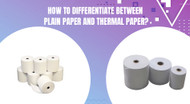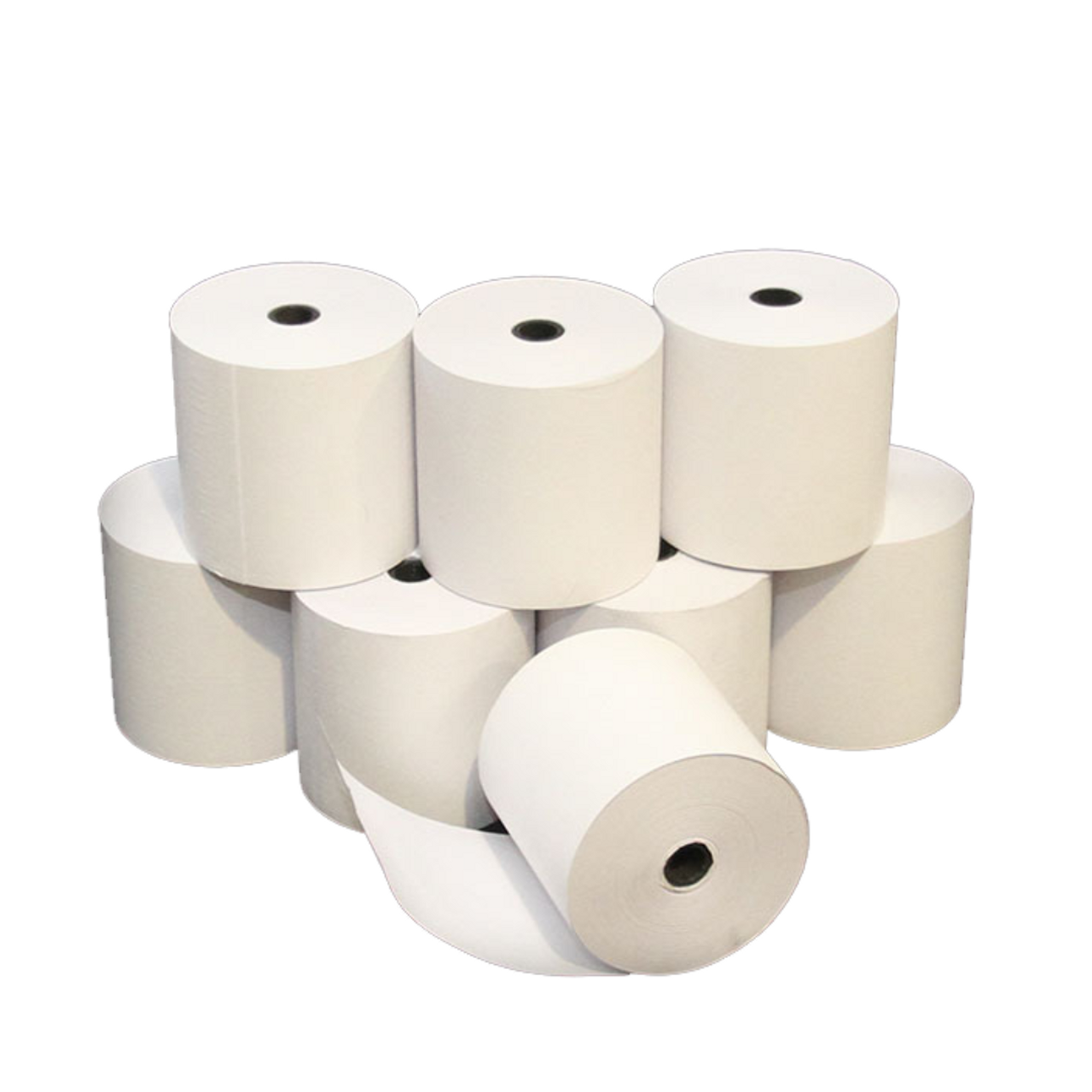How to Differentiate between Plain Paper and Thermal Paper?
In the modern world of printing, Point of Sale (POS) printing has gained immense popularity due to its efficiency and convenience in various industries. One essential component of POS printing is thermal paper, which plays a crucial role in producing high-quality receipts and other transactional documents.
This blog aims to provide a comprehensive understanding of POS printing, the types of POS printing, the benefits of thermal transfer printers, the significance of paper rolls, and the differences between plain paper and thermal paper for printing. Additionally, we will explore how to choose the right thermal paper for optimal printing results.
Let’s start by talking about
What is POS Printing?
POS printing, also known as Point-of-Sale printing is a specific type of printing used for generating receipts, invoices, and other transactional documents at the point of sale or service. It is an integral part of retail, hospitality, and service industries where quick and accurate printing is crucial for customer transactions.
Types of POS Printing
POS printing encompasses various methods, each designed to meet specific requirements. Let's explore two common types of POS printing:
- Thermal Printing: Thermal printing is a widely adopted POS printing method that utilises heat to create images or text on specially coated thermal paper. It offers speed, durability, and cost-effectiveness. Thermal printing includes two main techniques: direct thermal printing and thermal transfer printing.
- Direct Thermal Printing: In direct thermal printing, the thermal print head applies heat directly to the thermal paper, activating the chemicals in the coating and generating the desired image or text. This method is commonly used in applications such as receipts, labels, and tickets due to its simplicity and fast printing speed.
- Thermal Transfer Printing: Thermal transfer printing involves using a thermal transfer ribbon. The print head heats the ribbon, which then transfers ink onto the thermal paper, creating high-quality prints. This method is often preferred for barcode labels and product packaging.
- Dot Matrix Printing: Dot matrix printing, also known as impact printing, utilises a series of small pins to strike an inked ribbon against the paper, forming characters or images. This type of printing is less common in modern POS systems but still finds use in specific applications such as kitchen orders and multipart forms.
Difference between Standard Printing and POS Printing
Standard printing and POS printing differ significantly in terms of purpose, speed, and functionality.
- Purpose: Standard printing encompasses a broad range of printing needs, including documents, photographs, and marketing materials. In contrast, POS printing focuses specifically on generating transactional documents such as receipts, invoices, and tickets.
- Speed: POS printing priorities speed and efficiency to meet the demands of high-volume transactions. It is optimized for quick, on-the-spot printing, enabling businesses to serve customers promptly. Standard printing, on the other hand, may not have the same level of emphasis on speed.
- Functionality: POS printing often requires integration with point of sale systems and receipt printers to ensure seamless transactions and accurate record-keeping. It may involve specialised hardware and software configurations specific to the industry. Standard printing, however, is generally more versatile and adaptable to a broader range of printing needs.
Benefits of Thermal Printing
Thermal printing offers several advantages over traditional printing methods, making it an ideal choice for POS printing. Here are some notable benefits:
- Speed and Efficiency: Thermal printers can produce prints rapidly, resulting in improved productivity and reduced waiting time for customers. This is particularly beneficial in high-volume transactional environments, such as retail stores and restaurants.
- Cost-effectiveness: Thermal printing eliminates the need for ink or toner cartridges, reducing ongoing printing costs. Additionally, thermal printers often have fewer moving parts, leading to lower maintenance and repair expenses.
- Durability: Thermal prints are highly resistant to environmental factors such as water, oils, UV rays, and fading. This durability ensures that important information, such as receipts or labels, remains intact and legible for a longer duration.
Paper Rolls and Their Significance
Paper Rolls Online play a crucial role in POS printing, facilitating seamless printing operations. These rolls are designed to fit into thermal printers and provide a continuous supply of paper for printing receipts or transactional documents. They come in various sizes and lengths to accommodate different printer models and printing requirements. POS paper rolls offer convenience, ease of use, and cost-effective printing solutions for businesses.
Differences between Plain Paper and Thermal Paper for Printing
What is thermal paper?
Thermal paper, also known as thermal receipt paper or thermal printing paper, is a specialised type of paper that is commonly used in thermal printers. It is designed to produce high-quality prints through a heat-based printing process, eliminating the need for ink or toner. The surface of thermal paper is coated with a chemical layer that reacts to heat, resulting in the formation of text, images, or receipts. This makes thermal paper ideal for applications such as point-of-sale (POS) systems, cash registers thermal rolls, and other devices that require fast and efficient printing. Thermal paper is often sold in the form of paper rolls, commonly referred to as thermal paper rolls, which can be easily loaded into thermal printers. It offers advantages such as quick printing, smudge-free results, and low maintenance requirements. It's important to note that thermal paper should not be confused with bond paper, which relies on ink or toner for printing and is not suitable for thermal printers.
What is plain paper?
Plain paper, also known as bond paper (in POS terms), is a widely used type of paper that is suitable for various printing applications. Unlike thermal paper, plain paper is not coated with a specialised chemical layer for heat-based printing. Instead, it relies on ink or toner to produce text, images, or graphics. Plain paper is commonly used in inkjet printers, laser printers, copiers, and other standard printing devices. It comes in different sizes, weights, and finishes to accommodate various printing needs. When it comes to point-of-sale (POS) systems, thermal paper is the preferred choice due to its quick and efficient printing capabilities. Plain paper, however, is not compatible with thermal printers that require thermal receipt paper or thermal paper rolls. So, while standard plain paper is versatile for general printing purposes, it is essential to use the appropriate thermal paper for thermal printing applications.
Standard paper and thermal paper possess distinct characteristics that set them apart in the realm of printing:
- Printing Technology: Bond paper relies on traditional ink or toner-based printing technologies, whereas thermal paper utilises heat-based printing methods.
- Image Formation: Bond paper requires the application of ink or toner to form text or images, while thermal paper reacts to heat by creating images or text through a chemical reaction within the paper.
- Longevity: Thermal prints tend to have a shorter lifespan compared to prints on bond paper. Exposure to heat, light, or other environmental factors may cause thermal prints to fade over time.
- Purpose: Plain paper is versatile and suitable for a wide range of printing applications, including documents, brochures, and photographs. In contrast, thermal paper is specifically designed for transactional documents, receipts, and labels.
Choosing the Right Thermal Paper for Printing
When selecting the appropriate thermal paper for your printing needs, consider the following factors:
- Size and Compatibility: Ensure that the thermal paper roll you choose is compatible with your thermal printer model. Check the printer specifications for the recommended paper size and roll diameter.
- Image Quality and Clarity: Opt for thermal paper with a smooth, high-quality surface that ensures clear and legible prints. The paper should have a coating that is receptive to the thermal printing process.
- Durability: Consider the durability of the thermal paper, particularly if it will be exposed to harsh conditions. Look for paper that is resistant to fading, heat, moisture, and chemicals to ensure long-lasting prints.
- Environmental Considerations: Choose thermal paper that is eco-friendly and free from harmful substances like BPA (Bisphenol A). Look for certifications such as the Forest Stewardship Council (FSC) label, indicating sustainable sourcing and responsible manufacturing practices.
Can I Use Plain Paper on a Thermal Printer?
When it comes to using bond paper on a thermal printer, the short answer is No. Thermal printers are specifically designed to work with thermal paper, also known as thermal receipt paper. Thermal paper is coated with a special chemical that reacts to heat, resulting in the formation of text or images. This unique coating allows for efficient and high-quality printing without the need for ink or toner.
Bond paper, on the other hand, is not coated with this special chemical and cannot withstand the heat produced by a thermal printer. Using bond paper in a thermal printer can lead to poor print quality, smudging, and potential damage to the printer. Therefore, it is essential to use thermal paper rolls that are compatible with your thermal printer for optimal printing results.
It's worth noting that another type of paper commonly used in printers is bond paper, which is not suitable for thermal printing. Bond paper is uncoated and relies on ink or toner for printing, making it incompatible with POS thermal printer. So, be sure to choose the right type of paper for your specific printer to ensure efficient and high-quality thermal printing.
Conclusion
POS printing plays a pivotal role in various industries, providing fast and accurate printing of transactional documents. Thermal printing, with its numerous benefits, has become a preferred choice for POS systems due to its speed, efficiency, and cost-effectiveness. Understanding the differences between standard printing and POS printing, as well as the variations between plain paper and thermal paper, is essential in choosing the right printing solution for your business needs. By considering factors such as image quality, durability, and compatibility, you can make informed decisions when selecting the appropriate thermal paper for optimal printing results in your POS system.
If you are browsing the internet for the best thermal paper for sale at the best prices, POS Sales Australia is your one-stop shop. Be it an 80x80 Thermal Rolls Box of 48 or 76x76 2ply bonds rolls and Thermal 112 X 80 Paper Rolls, you name it and we have it at our store at competitive prices. Browse through our inventory and purchase the perfect pos paper for your printing needs today!
If you need further assistance? Contact us or call our POS expert at 1300 026 062


